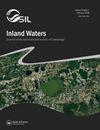Mass spectrometry imaging reveals the spatial distribution of essential lipids in Daphnia magna – potential implications for trophic ecology
IF 2.3
3区 环境科学与生态学
Q1 LIMNOLOGY
引用次数: 0
Abstract
ABSTRACT Lipids and fatty acids are key dietary components for the nutrition of organisms at all trophic levels. They are required to build cellular structures such as cell membranes, serve as energy storage, and take part in signal transduction cascades. For decades, ecological research investigated how dietary fatty acid availability contributes to the fitness of individuals and their populations. The omega-3 polyunsaturated fatty acid eicosapentaenoic acid (EPA) is of particular interest because its dietary availability determines the fitness of many aquatic consumers. Because of the small body size of zooplankton, only bulk tissue fatty acid analysis was previously performed, and thus the tissue-specific importance of EPA for zooplankton remained elusive. We used matrix-assisted laser desorption/ionization–mass spectrometry imaging (MALDI-MSI) to reveal the tissue-specific distribution of functional phospholipids in the herbivorous zooplankton Daphnia magna. We demonstrate several lipid species for heart, egg, gut, gonad, somatic, and neurological tissues of D. magna, including the compound eye as well as the optical and cerebral ganglion. The compound eye revealed a large diversity in lipid species containing EPA, which were also found in other neurological tissues and eggs. Such knowledge of tissue-specific fatty acid requirements is essential to investigate how selective allocation of dietary fatty acids within this key grazer affects processes on a functional and molecular level from the individual to food web scales. This methodological advancement will facilitate investigations on how invertebrate physiology and behaviour adjust to changing environmental conditions and potentially affect food web structures, including the trophic transfer of dietary fatty acids.质谱成像揭示了大水蚤必需脂质的空间分布-潜在的营养生态学意义
摘要:脂质和脂肪酸是所有营养级生物体营养的关键膳食成分。它们被要求构建细胞结构,如细胞膜,用作能量储存,并参与信号转导级联。几十年来,生态学研究调查了膳食脂肪酸的可用性如何有助于个人及其群体的健康。ω-3多不饱和脂肪酸二十碳五烯酸(EPA)特别令人感兴趣,因为它的饮食可供性决定了许多水生消费者的健康状况。由于浮游动物的体型较小,以前只进行了大量组织脂肪酸分析,因此EPA对浮游动物的组织特异性重要性仍然难以捉摸。我们使用基质辅助激光解吸/电离-质谱成像(MALDI-MSI)来揭示草食性浮游动物大型水蚤中功能性磷脂的组织特异性分布。我们展示了大型D.magna的心脏、卵子、肠道、性腺、体细胞和神经组织的几种脂质,包括复眼以及视神经节和脑神经节。复眼显示含有EPA的脂质种类有很大的多样性,在其他神经组织和卵子中也发现了EPA。这种组织特异性脂肪酸需求的知识对于研究这种关键食草动物体内膳食脂肪酸的选择性分配如何在功能和分子水平上影响从个体到食物网的过程至关重要。这一方法学进展将有助于研究无脊椎动物的生理和行为如何适应不断变化的环境条件,并可能影响食物网结构,包括膳食脂肪酸的营养转移。
本文章由计算机程序翻译,如有差异,请以英文原文为准。
求助全文
约1分钟内获得全文
求助全文
来源期刊

Inland Waters
LIMNOLOGY-MARINE & FRESHWATER BIOLOGY
CiteScore
6.10
自引率
9.70%
发文量
34
审稿时长
>12 weeks
期刊介绍:
Inland Waters is the peer-reviewed, scholarly outlet for original papers that advance science within the framework of the International Society of Limnology (SIL). The journal promotes understanding of inland aquatic ecosystems and their management. Subject matter parallels the content of SIL Congresses, and submissions based on presentations are encouraged.
All aspects of physical, chemical, and biological limnology are appropriate, as are papers on applied and regional limnology. The journal also aims to publish articles resulting from plenary lectures presented at SIL Congresses and occasional synthesis articles, as well as issues dedicated to a particular theme, specific water body, or aquatic ecosystem in a geographical area. Publication in the journal is not restricted to SIL members.
 求助内容:
求助内容: 应助结果提醒方式:
应助结果提醒方式:


